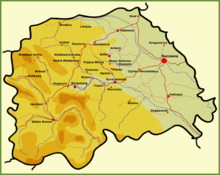Poles in Romania
.png)


According to the 2011 census, 2,543 Poles live in Romania, mainly in the villages of Suceava County (Polish: Suczawa). There are three exclusively Polish villages: Nowy Sołoniec (Solonețu Nou), Plesza (Pleșa) and Pojana Mikuli (Poiana Micului), as well a significant Polish presence in Kaczyca (Cacica) and Paltynosa (Păltinoasa). Poles in Romania form an officially recognised national minority, having one seat in the Chamber of Deputies of Romania (currently held by the Union of Poles of Romania) and access to Polish elementary schools and cultural centres (known as "Polish Houses").
History
The first Poles settled in Bukovina in the times of Casimir III. Most of the Poles immigrating after 1774 were looking for work. Polish miners from Bochnia and Wieliczka were brought to salt mines in Cacica. Another wave of Polish immigration arrived in Bukovina in the early 19th century, when the region was part of the Austro-Hungarian Empire, as was a significant portion of Poland. Around 1803 Polish highlanders from Čadca (Polish: Czaca, Czadca) settled in Treblecz (Tereblecea) by Siret, in Stara Huta Krasna and in Kaliczanka and again in 1814-1819, this time settling in Hliboka (Adâncata) and Tereszna. Nowy Sołoniec was settled in 1834, Plesza in 1835 and Pojana Mikuli in 1842.
Southern Bukovina was a very attractive place to live in because of Austria's policy not to conscript recruits into its army from there (service in the Austrian army at that time was for a 14-year term). Moreover, Bukovina was free from serfdom, attracting immigrants of German, Jewish, Czech, Slovak, Russian, Italian, and Polish nationality.
There were probably other waves of migration from Poland after the November and Kraków Uprisings, but most Poles were from peasant families relocated there by the Empire's authorities after they participated in the Jakub Szela insurrection. However, after the Hungarian Revolution of 1848, the Poles, which were one of main minorities in Romania – got massacred by the Romanians due to Polish supports for Hungarians at the revolt.
There were about 80,000 Poles living in Romania in 1939, but only about 11,000 remained in 1949 after Romania lost Bessarabia and Northern Bukovina (the most important Polish community lived in Czerniowce, now in Ukraine).
Communes with the highest Polish population percentage
- Suceava County
- Cacica — 20.04%
- Mănăstirea Humorului — 19.3%
- Mușenița — 4.06%
- Moara — 3.23%
- Păltinoasa — 1.14%
Notable Polish-Romanians
- Michał Belina-Czechowski, Seventh-Day Adventist preacher
- Tytus Czerkawski, politician
- Izydor Kopernicki, physician
- Ghervazen Longher, politician
- Iosif Malinovski, Roman Catholic vicar and publisher
- Gustaw Otręba, physician
- Witold Rola Piekarski, cartoonist and academic
- Feliks Wierciński, Roman Catholic priest and schoolteacher
External links
- (Polish) Polonia w Rumunii
- (Polish) / (Romanian) Polscy uchodźcy w Rumunii 1939–1947. Dokumenty z Narodowych Archiwów Rumunii / Refugiații polonezi în România 1939–1947. Documente din Arhivele Naționale ale României, t. 1, cz. 1 i 2*The Polish organization in Romania
- Polish minority in Cacica - Romania
- Cacica, Romania - Foto Galery
- Cacica, Romania - Panoramio